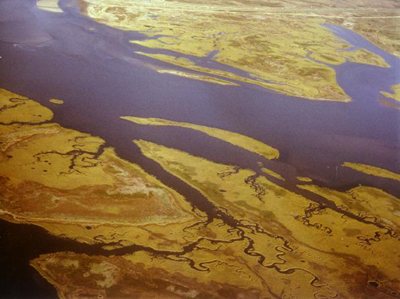The southern African coastline from Maputo Bay in Mozambique in the east to Angola in the west is uniquely characterized amongst southern hemisphere coastlines by the combination of few near shore islands, strong wave action, especially in the southern Cape, and the very small number of sheltered bays. Our estuaries are therefore virtually the only protected coastal habitats which are able to provide, generally in their lower reaches, an environment which combines predominantly marine or near marine salinity’s, shelter from wave action and relatively fine sediments. This combination is preferred by a variety of animal and plant species.
A universal and characteristic feature of estuaries is the variation in physical and chemical conditions, both along the length of the system and over time in any one area. This time variation often occurs over periods measured only in hours or days for example tidal cycles and differences in daily flow patterns and is therefore much shorter than the annual seasonal cycles of temperature, day length and rainfall. The magnitude of the daily tidal fluctuations may, however, often be equal to that of annual variations which, means that the organisms living in this highly variable environment, must be able to cope with these changes. The source of much of this variation, which is a major characteristic of “open mouth” estuarine systems, lies in the daily rise and fall of the tides, currents set up by these tides and fluctuating freshwater inflow.

Estuaries are dynamic systems and virtually any physical or chemical feature associated with them is subject to rapid and sometimes extreme changes. The mouths of South African estuaries unless pinned by some rocky feature tend to meander under the influence of currents, wind and wave action and sediment movement. Under flood conditions major mouth changes involving thousands if not millions of cubic meters of sand may occur in a few hours. Attempts to secure and stabilize mobile mouth areas, particularly in the case of larger systems are frequently doomed to failure. This was graphically demonstrated at St Lucia during the floods associated with Cyclone Domoina in 1984 when, as shown in the accompanying pictures, a tarred access road to a car park on the northern bank of the estuary mouth which was supported by concrete retaining walls and protective dolosse was completely destroyed.
Estuarine mouths represent dynamic equilibrium. Marine derived sediments are forced into the mouth by long shore drift, wave action and flood tide currents which may ultimately block off the mouth. The scouring effects of floods act as opposing forces and re-set the whole system before the marine driven mouth sedimentation and closure processes start again. Salinity fluctuations are typical and normal and most estuarine species have remarkably wide tolerance ranges, although the effects of low salinities become more severe in the eastern and southern Cape where floods tends to be associated with low temperatures, generally well below 20 oC. Under these conditions the more tropical species such as the mangrove crab may suffer severe mortality as was found by Hill (1975) in the Kleinemonde near Port Alfred. No crab mortalities were noted at St Lucia following Cyclone Domoina when the water temperatures were about 27 oC.
High salinities are less frequent but are nevertheless a feature of west coast estuaries and also St. Lucia during drought years when this very large, shallow system is subject to high evaporation rates. Most estuarine invertebrate animals seem to be able to tolerate salinities up to about 500 ppt (normal seawater is 35‰). Many estuarine fish seem to be able to survive salinities of 60 to 700 ppt; (Whitfield, Blaber & Cyrus 1981). Large scale temperature or salinity induced mortalities of estuarine organisms have therefore been relatively rare and localised to date. However, this can be expected to increase as freshwater abstraction from rivers becomes more intensive and marine exchange or freshwater input does not compensate for evaporation in estuaries with long tidal reaches or extensive shallow areas.